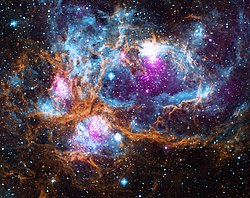NGC 6357
NGC 6357 is a H II Region diffuse nebula near NGC 6334 in the constellation Scorpius. The nebula contains many proto stars that are protected by dark discs of gas. It also contains young stars wrapped in expanding "cocoons" or expanding gases surrounding these small stars. The nebula is also known as the Lobster Nebula.[1][2] It was given the name War and Peace Nebula by the Midcourse Space Experiment scientists because of its look. In infrared images the bright, western part looks like a dove and the eastern part looks like a skull.[3] Anime fans tried to get NASA to rename it as the Madokami nebula because it was like a character from the Madokami anime, The name was not changed.[4][5]
| NGC 6357 | |
|---|---|
 NGC 6357 composite image. | |
| Observation data: J2000 epoch | |
| Type | Emission Nebula |
| Right ascension | 17h 24m |
| Declination | –34° 20 |
| Distance | 5,500 ly |
| Constellation | Scorpion |
| Physical characteristics | |
| Other designations | War and Peace Nebula, Lobster Nebula, Sharpless 11, RCW 131, Gum 66, Madokami |
| See also: Diffuse nebula, Lists of nebulae | |
Distance
The nebula is about 5,500 light years from Earth.[6]
Associated open clusters
Pismis 24
This nebula includes the open cluster Pismis 24. There are many massive stars in this cluster. One of the brightest stars in the cluster i, Pismis 24-1, It was thought to be the most massive star on record. The star measures almost 300 solar masses. It was later learned that it was a multiple system of at least three stars. These three stars are each near 100 solar masses. This makes them among the more massive stars on record.[7][8]
G353.2+0.7
The young stellar cluster G353.2+0.7 lies at the east of Pismis 24. It was revealed by a Chandra X-ray image showing about 800 stars.[9]
G353.1+0.6
The young stellar cluster G353.1+0.6 lies at the southeast of Pismis 24. It has about 800 stars that were detected by X-ray.[10] The region includes many O-type stars, including [BDSB2003] 10.[11]
NGC 6357 Media
A Hubble Space Telescope (HST) image of Pismis 24-1, the "core" of NGC 6357.
Dark Energy Camera captures the star-forming nebula NGC 6357
References
- ↑ "Lobster Nebula – birthplace of stars – revealed in infrared". the Guardian. 2013-02-20. Retrieved 2022-11-03.
- ↑ Space com Staff (2013-02-25). "Lobster Nebula Seen with ESO's VISTA Telescope Space Wallpaper". Space.com. Retrieved 2022-11-03.
- ↑ "2MASS Picture of the Week Archive". www.ipac.caltech.edu. Retrieved 2022-11-03.
- ↑ Yomimaid. "There Is A New Petition To Name A Nebula After "Ultimate Madoka"". Crunchyroll. Retrieved 2022-11-03.
- ↑ "NGC 6357. The Lobster Nebula – Astrodrudis". Retrieved 2022-11-03.
- ↑ Hanneke Weitering (2016-12-20). "'Winter Wonderland' Glows in Space as Nebula Is Wreathed in Wintry Colors". Space.com. Retrieved 2022-11-04.
- ↑ "ESA Science & Technology: Star on a Hubble diet NGC 6357". 2007-04-04. Archived from the original on 2007-04-04. Retrieved 2022-11-14.
- ↑ "APOD: 2006 December 19 - Massive Stars in Open Cluster Pismis 24". apod.nasa.gov. Retrieved 2022-11-14.
- ↑ Townsley, Leisa K.; Broos, Patrick S.; Garmire, Gordon P.; Bouwman, Jeroen; Povich, Matthew S.; Feigelson, Eric D.; Getman, Konstantin V.; Kuhn, Michael A. (2014-06-11). "The Massive Star-forming Regions Omnibus X-ray Catalog". The Astrophysical Journal Supplement Series. 213 (1): 1. arXiv:1403.2576. doi:10.1088/0067-0049/213/1/1. ISSN 0067-0049. S2CID 250867819.
- ↑ Townsley, Leisa K.; Broos, Patrick S.; Garmire, Gordon P.; Bouwman, Jeroen; Povich, Matthew S.; Feigelson, Eric D.; Getman, Konstantin V.; Kuhn, Michael A. (2014-06-11). "The Massive Star-forming Regions Omnibus X-ray Catalog". The Astrophysical Journal Supplement Series. 213 (1): 1. arXiv:1403.2576. doi:10.1088/0067-0049/213/1/1. ISSN 0067-0049. S2CID 250867819.
- ↑ Damke, G.; Barbá, R.; Morrell, N. I. (2006-06-01). "The open cluster G353.1+0.7 in NGC6357". Revista Mexicana de Astronomia y Astrofisica Conference Series. 26: 180. Bibcode:2006RMxAC..26..180D.


